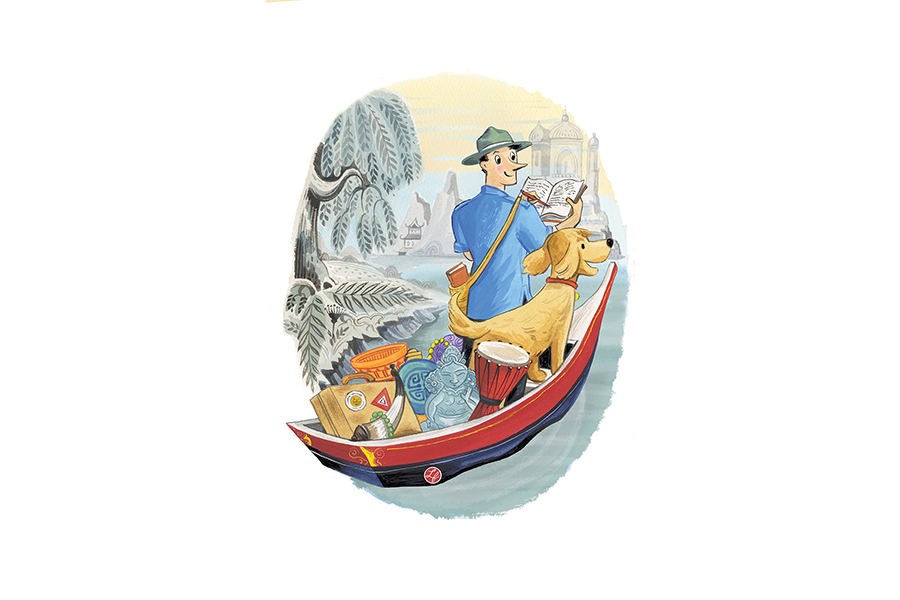How Layla and I traveled the world
Loading...
Thirteen years ago I fell in love with a white ball of fur that wagged its tail at me from behind the bars of a city dog pound. I was about to quit a steady job to follow my dream of becoming a travel writer, a potentially disastrous idea about to be compounded by adding another mouth to feed – not to mention an animal that would need care during my long absences. I never gave it a second thought.
She had me at the first wag.
Layla quickly made the connection between seeing my bags spread across the bed and my leaving on a trip. She was adept at conveying her displeasure with her body language. For my homecomings we soon established the ritual of my spreading the contents of my bags across the patio for her to roll in and revel in the exotic smells of faraway places mixed with my own travel stench. Her disappointment at my departures was more than compensated for by our reunions.
And when I sat to write my stories, she would station herself on the daybed next to my desk and we would have extended (often nonverbal) conversations about where I’d been and what I’d seen. We communicated with each other as only animals and those who love them can.
I would read aloud to her what I’d written and she would cock her head or wag her tail in dissent or agreement. Sometimes she’d offer a “woof!” for emphasis. If she turned away to concentrate on cleaning a paw, I knew I had to start over.
Of course she didn’t understand what I was writing. But this exercise with her was my means of self-editing. It was the way I strove to push a story to a higher level. Assigning a voice to Layla in this process turned a task into a joy.
She became my muse and my virtual partner in my travels.
Watching her reactions to my work forced me to modulate my voice and pay attention to nuances. Not only was I bouncing ideas off her, I was also telling her the story as though she were a reader. This helped shape what I put on the page. Having such a ready and patient audience, and critiquing my writing through her voice, made me a better writer.
Telling her my stories took me back to those places in my mind. It allowed me to relive my experiences and scour them for the details that could make the story soar, details that sometimes get lost in the larger telling but are, in themselves, tiny gems of experience. Layla helped me dig for those gems the way she did for a bone.
In this way, we traveled vicariously together. We visited remote tribes in Africa, took a small boat up the Mekong River in Vietnam, rode camels across the Sahara in Mali, and kayaked among killer whales in Alaska. We circled the world – Layla mentally at my side – at least twice.
On two occasions Layla herself got to stand in the literary spotlight: She appeared in a story in The Christian Science Monitor when she joined the entourage of a Hollywood canine actor.
Another time she “wrote” a guest dog column for a local city blog. In both cases, of course, they were my words, her “voice.”
Her dog toys were exotic knickknacks I’d brought home from abroad: a plastic float from a Japanese fishing net (she loved to chew on it), a stuffed toy tiger from Cambodia, a leather ball from northern China. Her collar was a hand-beaded item made by the Masai of Kenya. Layla was an international dog.
I have no words to describe the bond that connected me so closely to her, and I am sure that, by this point, some readers are scoffing at the possibility of such a connection. That’s fine. Others of you, dog people like me, will know it’s true and understand.
Ever since the first wolf joined early humans by a campfire there has been an undefinable link between human and dog. Some might say it’s an unequaled bond. That’s what Layla and I shared.
Today I am a travel writer, and my heart is broken because my friend of so long is gone. Like many old friends, she and I shared much over the years, and I’m so grateful to her. Whatever success I’ve had as a travel writer I assign in large part to her being at my side for all those years, listening and simply loving.
It does not matter if she never understood a word I said or that she never left our home. She was my travel partner and always will be.







